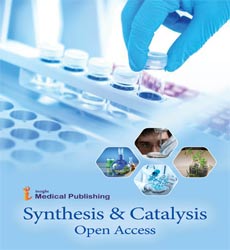ISSN : 2574-0431
Synthesis and Catalysis: Open Access
Molecular Mechanisms and Synthetic Applications in Green Chemistry
Rozkiewicz Brug
Department of Chemical Engineering, Tsinghua University, Beijing, China
*Corresponding author:
Rozkiewicz Brug
Department of Chemical Engineering, Tsinghua University, Beijing, China
Email: rozkiewicz.brug@iez.cn
Received: February 01, 2025, Manuscript No. ipscoa-25-20549; Editor assigned: February 03, 2025, PreQC No. ipscoa-25-20549; Reviewed: February 15, 2025, QC No. ipscoa-25-20549; Revised: February 20, 2025, QI No. ipscoa-25-20549; Published: February 28, 2025, DOI: 10.21767/2574-0431.2025.11.1.02
Citation: Brug R (2025) Molecular Mechanisms and Synthetic Applications in Green Chemistry. Synth Catal Vol: 11 No: 1: 02.
Introduction
Molecular mechanisms in green chemistry are closely tied to the concept of catalysis, which lies at the core of sustainable synthesis. Catalysts function by lowering activation energy, enabling reactions to proceed with reduced energy inputs and higher selectivity. The precise molecular mechanisms through which catalysts operateâ??whether through substrate activation, transition-state stabilization, or cooperative interactionsâ??dictate the efficiency and sustainability of a process. For example, transition metal catalysts enable hydrogenation, carbonâ??carbon coupling, and oxidation reactions with remarkable specificity. Recent molecular innovations have enhanced their performance by tuning ligand structures to optimize electron donation and steric environments. Understanding these mechanisms at the molecular level allows chemists to minimize byproducts, reduce reliance on hazardous reagents, and design recyclable catalytic systems, thereby achieving greener outcomes [1].
Description
Biocatalysis exemplifies the molecular elegance of green chemistry, where natureâ??s enzymes act as sustainable catalysts. Enzymatic catalysis operates through highly specific binding and transition state stabilization, often described by Michaelis-Menten kinetics. Unlike traditional catalysts, enzymes work under mild conditionsâ??aqueous environments, ambient temperature, and neutral pHâ??reducing the need for energy-intensive conditions. Advances in molecular biology and computational chemistry have revealed the intricate mechanisms of enzyme action, from proton shuttling and cofactor-mediated electron transfer to conformational changes that enable substrate specificity. These mechanistic insights have been leveraged in synthetic applications ranging from pharmaceutical production to agrochemicals. For instance, engineered transaminases and ketoreductases now catalyze stereoselective transformations in drug synthesis, replacing multi-step chemical routes with single-step enzymatic processes [2].
Another vital molecular mechanism in green chemistry is photocatalysis, where light energy drives chemical transformations. At the molecular level, photocatalysts operate by absorbing photons to generate excited states, which then transfer electrons or holes to substrates, initiating redox processes. Semiconductor-based photocatalysts, such as TiOâ??, ZnO, and graphitic carbon nitride, operate through band-gap excitation, producing reactive oxygen species or reducing equivalents for transformations like water splitting or pollutant degradation. Molecular photocatalysts based on transition-metal complexes (e.g., Ru(II) or Ir(III) polypyridyl complexes) enable visible-light-driven reactions through photoinduced electron transfer [3].
Electrocatalysis represents another frontier of molecularly driven sustainability. By applying an external potential, electrocatalysts drive redox reactions such as hydrogen evolution, oxygen reduction, and carbon dioxide reduction. At the molecular level, electrocatalysis involves adsorption of reactants on electrode surfaces, electron transfer through catalytic sites, and desorption of products. Molecular tuning of electrode materials, such as doping with heteroatoms or engineering nanostructures, enhances activity and selectivity. Synthetic applications include the electrochemical production of hydrogen as a clean fuel, ammonia synthesis through electrochemical nitrogen reduction, and COâ?? electroreduction to fuels and chemicals such as methanol and formic acid. By integrating renewable electricity sources, electrocatalytic processes align perfectly with green chemistryâ??s emphasis on energy efficiency and reduced carbon footprints. Solvent design is another domain where molecular mechanisms inform green chemistry. Solvents often account for the majority of mass in chemical processes, making their sustainability crucial. Molecular understanding of solventâ??solute interactions has enabled the design of greener solvents that minimize toxicity and waste. Ionic liquids, for example, are salts that remain liquid at low temperatures due to molecular interactions that disrupt lattice formation. Their tunable cationâ??anion combinations allow chemists to design solvents with desired polarity, solubility, and thermal stability [4,5].
Conclusion
The integration of molecular mechanisms into synthetic applications has redefined the landscape of green chemistry, offering a sustainable alternative to traditional chemical processes. From the catalytic cycles of transition metals and enzymes to the light-driven pathways of photocatalysts and the electrochemical precision of electrocatalysts, molecular understanding has unlocked transformative strategies for chemical synthesis. Green solvents, renewable feedstocks, and nanomaterial-based catalysts further demonstrate how molecular insights translate into practical, eco-friendly manufacturing processes. Importantly, these innovations not only minimize waste and energy consumption but also enable the design of new products, polymers, and fuels that align with circular economy principles. While challenges of scalability, cost, and environmental assessment remain, the trajectory of green chemistry is undeniably shaped by molecular-level innovation. By continuing to explore, understand, and manipulate molecular mechanisms, chemists and engineers are building a foundation for sustainable synthetic applications that ensure industrial progress while safeguarding ecological health.
Acknowledgement
None.
Conflict of Interest
None.
References
- Froimowitz M (1993). HyperChem: A software package for computational chemistry and molecular modeling. Biotechniques, 14: 1010-1013.
- Magar HS, Hassan RY, Mulchandani A (2021). Electrochemical Impedance Spectroscopy (EIS): Principles, construction and biosensing applications. Sensors 21: 6578.
Google Scholar Cross Ref Indexed at
- Tay KS, Rahman NA, Abas MRB (2013). Ozonation of metoprolol in aqueous solution: Ozonation by-products and mechanisms of degradation. Environ Sci Pollut Res 20: 3115-3121.
Google Scholar Cross Ref Indexed at
- Bound JP, Voulvoulis N (2005). Household disposal of pharmaceuticals as a pathway for aquatic contamination in the United Kingdom. Health Perspect 113: 1705-1711.
Google Scholar Cross Ref Indexed at
- Chen L. Lu D, Zhang Y (2022). Organic compounds as corrosion inhibitors for carbon steel in HCl solution: A comprehensive review. Materials 15: 2023. Materials15: 2023.
Open Access Journals
- Aquaculture & Veterinary Science
- Chemistry & Chemical Sciences
- Clinical Sciences
- Engineering
- General Science
- Genetics & Molecular Biology
- Health Care & Nursing
- Immunology & Microbiology
- Materials Science
- Mathematics & Physics
- Medical Sciences
- Neurology & Psychiatry
- Oncology & Cancer Science
- Pharmaceutical Sciences
